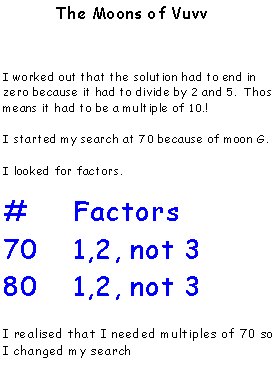Copyright © University of Cambridge. All rights reserved.
'The Moons of Vuvv' printed from https://nrich.maths.org/
Show menu
"I enjoy your website", wrote Becky , from Carleton St Hilda's C. of E. Primary School. Becky explained how she began her solution search:

Now, I wonder what Becky changed her search to? If Becky is going to change her search to try and arrive at an answer perhaps she wants to think about this idea.
Alex and her family from Leicester, England worked on this Vuvvian problem. Alex explains how they set about arriving at a solution:
- We started off by doing the seven times table, because that was how long the last moon took to go round Vuvv.
- Next, we checked if the multiples of seven were also in the 2x, 3x, 4x, 5x, 6x tables. This was so we'd know if they (Vuvv moons) would line up.
- We got fed up working out the multiples of seven, because they got way too big. So, we used a calculator! We pressed +7=== to get the multiples of seven.
- We found out that it would take 210 Vuvvian years between each super eclipse.
However, I'm not sure that 210 is a multiple of all of the numbers 2, 3, 4, 5, 6 and 7, is it?
Anita and Jing Jing from Kilvington Girls' Grammar in Australia, think that's only the half of it...in fact, they think that it is 420 year wait between Super-eclipses.
Franco and Jonny from Northamptonshire agree that is it 420. They say:
We started off with 42. Every number goes into 42, except 5, so we multiplied it by 5.
6 doesn't go into 210, so we went back to 42. We then multiplied 42 by 10, to get 420. We checked by dividing 420 by 1, 2, 3, 4, 5, 6 and 7. They are all factors of 420. So the overall answer is 420.